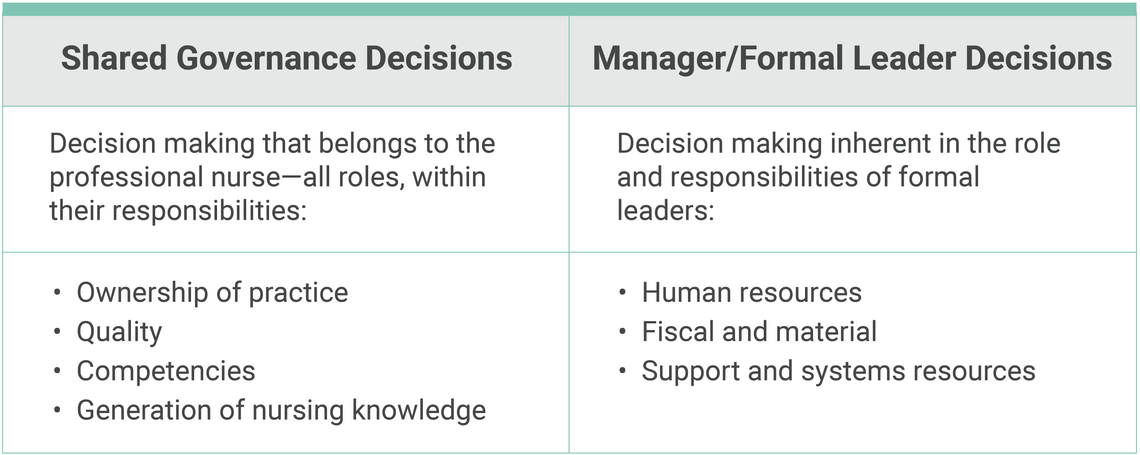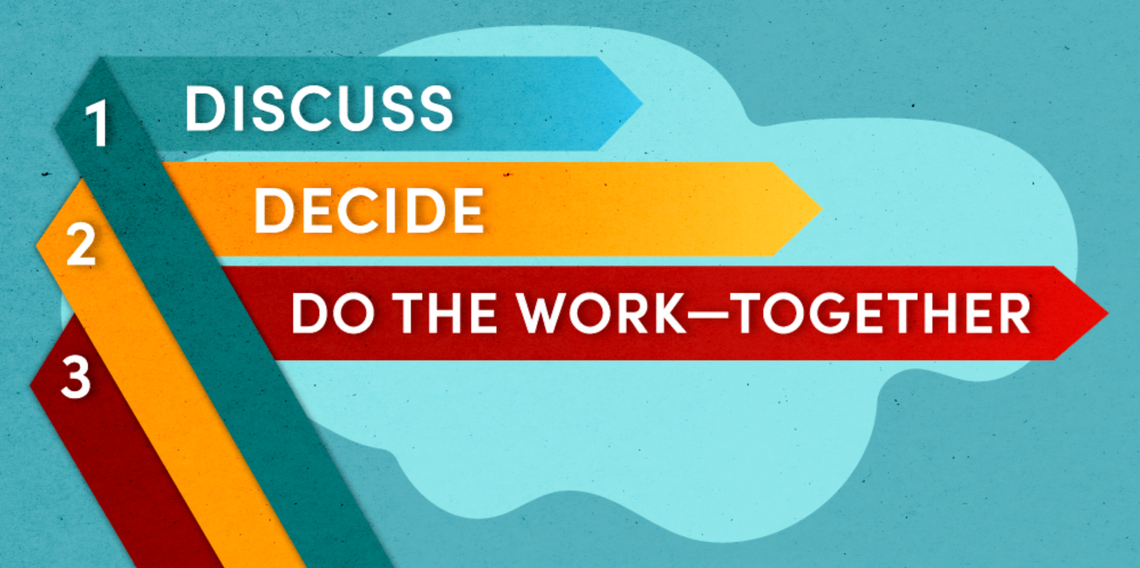Not About Nursing, Without Nursing
A core tenant of Shared Governance is that all decisions that impact nursing practice need to include a nurse. Nursing practice involves direct or indirect patient care. It can include clinical practice, nursing administration, education, research, and consultation.
For those outside of nursing who make decisions that may impact nursing practice, email AskNursing@hsc.utah.edu to be connected with a council member who can help.
he official start of nursing shared governance has frontline teams excited to share their thoughts. While it’s tempting to try and tackle everything we don’t like about our jobs, much of what we do as a department is interconnected with other disciplines and workflows that are part of the larger organization.
What shared governance is—and is not
Shared governance is a professional practice model that ensures nurses have a voice in decisions affecting their practice and professional growth. It's not about nurses acting independently without regulation or oversight.
Part of our duty as nurses is to fulfill the social mandate of our profession by striving for the best outcomes for those under our care:
Clinical nurses are responsible and accountable for decisions within their scope of practice.
What decisions can teams make on their own?
The following table helps clarify what falls within- and outside-of nursing shared governance decision making:

Shared Governance
Nursing teams have agency over their practice through the development of professional standards and practices. Involvement is expected, not an invitation. How nurses care for patients requires their input, engagement, and investment.
Examples:
- Oxygen weaning protocols
- Central line care
- Bedside report
- Patient rounding
- Rapid response
- Nurse triage
Nursing teams are responsible to demonstrate a level of engagement to advocate for those they serve, deliver quality outcomes, and improve standards and practices of the profession.
Examples:
- Promoting EBP (evidence-based practice)
- Monitoring nursing clinical sensitive indicators and implementing evidence-based nursing interventions to meet benchmark:
- CAUTI (catheter associated urinary tract infections)
- Preventive maintenance health measures (e.g., depression screening, diabetes management)
- CLABSI (central line-associated blood stream infection)
- Patient falls with injury
- HAPI (hospital acquired pressure injury)
Nurses are charged with developing and validating their own competencies.
Examples:
- Checklists
- Finding out what skills you need to learn each year and figuring out how to check if you've learned them
- Peer eval (not in place yet)
Nursing professionals are responsible for continuing to deepen their knowledge for high quality patient care.
Examples:
- Embracing forward thinking, innovation, and improvements for the care we deliver to patients
- Promoting a spirit of inquiry and engagement in nursing research
- Dissemination: contribute to the professional body of work
- Present at a Poster Fair or conference
- Publish an article
Manager/Formal Leader
Managers are formally responsible for managing human resource needs of employees.
Examples:
- Hire and retain talent
- Conduct performance evaluations
- Track and monitor team performance and initiate action to strengthen results
- Address performance problems and terminations
- Support team problem resolution and decision-making (resolve conflict)
Managers are responsible for ensuring team operations stay within budget.
Examples:
- Manage operating budget, including: revenues and expenditures, accounting, payroll, and financial reporting
- Ensure team expenses do not exceed the allocated budget
- Ensure material needs are met (supplies, equipment, etc.)
- Oversee purchasing and direct funding requests
Managers are responsible for ensuring team members can be successful in their work.
Examples:
- Goal setting, including: action items, strategies, and resources needed
- Recognize team efforts and accomplishments
- Promote professional growth opportunities and engage staff in stretch assignments
- Connect team members with organizational resources based on needs
What about well-being?
Ready to get started?

Follow the 3 D’s of Decision Making Framework, a guide for working on PINS as a team.
We know that quite a few team council PINSPINS are problems, ideas, needs, suggestions surfaced by team members as part of the shared governance process. address issues that pertain to well-being. While “well-being” isn’t listed in the shared governance decision making process, we are all responsible and accountable—leaders and teams alike—to identify PINS about well-being and work collectively toward solutions.
Address well-being PINS as you would any other; follow The 3 D’s of Shared Governance Decision Making and proceed accordingly.
If you still have questions, please email AskNursing@hsc.utah.edu. We’re happy to help!
Annie Kamerath
Consuelo Ogden
Jannda Bartlome
Kim Mahoney
Mary-Jean (Gigi) Austria
Sara Clark
Tina Hepner
Zlata Muhamedagic
Shared governance is a decision-making model designed to empower the people who care for patients. Chief Nursing Officer Tracey Nixon explains what it is, how it impacts you, and what to expect in the coming months.
As teams across the UUHC Department of Nursing work to implement shared governance in their areas, we’re learning about team experiences and the impact shared governance has had so far. This month, Lauren Studiner from HCH 4B shares how shared governance helped her team overcome workflow challenges and create a more inclusive culture around idea-sharing and decision-making.
As teams across the UUHC Department of Nursing work to implement shared governance in their areas, we’re learning about team experiences and the impact shared governance has had so far. This month, Brenda Baker from Radiation Oncology shares how her team leveraged shared governance to break down workflow barriers.
